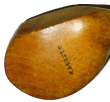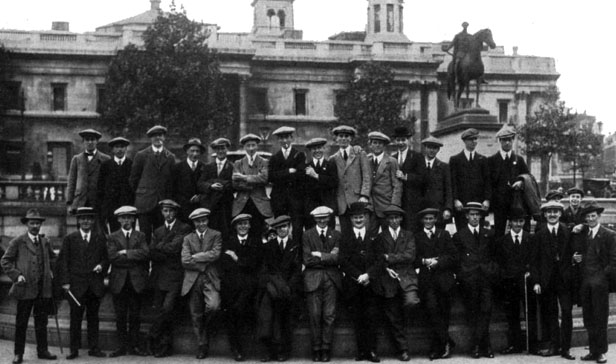
|
Registration Edit profile catalogue auction shopping cart shipping history makers search faq news links about contact |

Scottish Golf History
ClubmakersThe Niblick Brigade(Source: © 2014-21 Douglas MacKenzie FSAScot) There was fierce debate about golf, and sport in general, in the early stages of the First World War. Why should sports played by able-bodied young men continue when their contemporaries were fighting at the front? This, combined with some rather unpleasant allegations of cowardice in letters to newspapers, and Kitchener’s massive recruiting campaign, led to the formation of ‘sporting battalions’. The first and most notable in Scotland was McCrae’s Battalion, where thirteen professional players from Heart of Midlothian, then top of the Scottish league, became the first footballers in Britain to volunteer in November 1914. They were joined by players from Hibernian, Dunfermline, Raith Rovers and Falkirk and many supporters and, within seven days, Lieutenant-Colonel Sir George McCrae MP had raised a full complement of 1350 recruits. They were decimated in the slaughter of the first day of the Battle of the Somme on 1 July 1916 where 20,000 British soldiers died and 40,000 were injured. Professional golfers also volunteered early in the war both to local regiments and en masse to what became known as the Niblick Brigade, 13th Battalion, the Rifle Brigade. Much nonsense has been written about them and about golf in general during the war. For example Tom Tate, For Team and Country - Sport on the Frontlines of the Great War, John Blake Publishing, London, 2014 ‘But perhaps the most remarkable use of time, land and manpower was to be found in Flanders. At Ypres, scene of one of the earliest brutal battles of the war, the Honourable Artillery Company had constructed a golf course. It had been designed by Ramsey Ross, a professional golfer, serving with the regiment and was, inevitably, for the use of officers only – among whom were 26 volunteers of the soi-disant ‘Niblick Brigade’ This passage regurgitates the clichés of landowners sending their gamekeepers to do the fighting while sheltering far from the front. Trying to make golf fit this model is simply incorrect. Firstly, as we shall see later, the niblick brigade was not comprised of officers. Secondly, it was part of the Rifle Brigade, nothing to do with the Honourable Artillery Company, of which Ramsey Sprigg Ross (1896-1966) was a member but was never a professional golfer. Indeed, in the previous census (1911) to the first battle of Ypres he was a 15 year old schoolboy. In terms of golf only being for officers, the following report from Mr Millholm, presumably a private or a corporal in the Glasgow Highlanders with the well-known professional, Tom Fernie, also a corporal, contradicts that, “In the afternoon Tom and I set out along with one of our sergeants for – what do you think? Well! I had better tell you, as you would never guess. A game of golf. Golf was both a part of life for many soldiers and actively encouraged by the High Command for morale and fitness and ‘as a great tonic for returning soldiers’. For evidence of the former, Henry Leach wrote in The American Golfer in 1917, ‘some bold fellow of British or American blood will get up on the parapet of a trench with a driver or an iron, will play a ball across No Man's Land to a certain spot in the receding German ground and — lo! he will make the hole he has set for himself in a single shot!’ and to show that clubs in the trenches were far from merely a remembrance of things past he recalls, ‘a friend of mine, who is a lover of the game and who was recently wounded, when seeing the troops who had taken Thiepval from the Germans marching by, discovered one of them with a captured mashie in his hands'. In terms of using golf to boost morale, many clubs provided golfing facilities for service personnel passing through or stationed in the vicinity. In March 1915, for example, the Cirencester Golf Club played a 12 a side match against the 10th Gordon Highlanders. Of the Gordons’ players only four were officers. For what the older professionals did one need look no further than the many exhibition matches played by Braid, Vardon, Taylor and Ray (who despite his strength and long drives was rejected for military service) to raise funds for the Red Cross and other wartime charities. In the field, J L C Jenkins, the amateur champion from the Troon club and Gordon Lockhart, then a successful amateur and later a professional were, again from Henry Leach’s writing, ‘when in the novitiate stage of their military careers brought together for a game for their own good and the edification of others’. As for the niblick brigade, it was originally the idea of Charles Mayo, and Albert Tingey, with strong support from George Duncan, but soon adoped enthusiastically by the Professional Golfers Association who announced on 10 September 1914. ‘The Professional Golfers’ Association has taken over the proposal that facilities should be given golf professionals and their friends to enlist in the same regiment. Nearly 50 names have already been received and others desirous of joining the corps should send their names and addresses at once to the secretary.’ Perhaps it was the restriction that only single men were eligible which reduced the number of full professionals volunteering this way. This did not stop professionals enlisting in other regiments and there were two Sportsman’s Battalions (23rd and 24th) of the Royal Fusiliers. Based on inaccurate contemporary reports such as the one from the Newcastle Journal below, Harry Fulford is often cited as a golf professional serving with the Niblick Brigade but in fact he enlisted with the 2nd Sportsman’s Battalion of the Royal Fusiliers in Bradford in January 1915. This was also the case with James Bradbeer, Robert Jacobs and Ernest Jones. As early as December 1915 the Dundee Evening Telegraph reported ‘Of the Professional Golfers Association, over sixty members and sixty assistants are serving’ and another article on this site remembers those who did not come back. So the niblick brigade was made up largely of assistant professionals though many went on to have post-war golfing careers. They had a luncheon in Gatti’s restaurant in London before assembling at Trafalgar Square 'and marched in a body to the nearest recruiting office. All but three successfully passed the doctor and left the same afternoon to join the Rifle Brigade [King's Royal Rifles] at Winchester' (forming part of the 13th Battalion).
In August 1916 the Newcastle Journal reported ‘It was stated at a meeting of the Professional Golfers Association that, though not officially reported, of the assistants in the “Niblick Brigade” only five had escaped injury but that none of the wounds were serious. J Simmons, formerly assistant to Sherlock, had been killed and H Fulford had been injured with shrapnel in the back and was now at Le Touquet’. This contradicts the ‘official’, or at least more commonly reported, story that L/Cpl W G Eastland, who reported perhaps the first injury to a colleague in the Niblick Brigade in a letter home (Herbert Line being shot in the face but surviving) was the first casualty of the Niblicks, dying from wounds after being shot in the lung in the Battle of Ancre during the Somme offensive in 1916. He lived in Woodmansterne, Surrey, and is noted on the 1911 census as an assistant professional, perhaps at the local course of Woodcote Park although he was first elected to the PGA the following year as an assistant at Thanet in Kent. After the war (at least in the early 1930s), the professionals of the 13th Battalion got together to play an annual match against the amateurs of the Rifle Brigade Golf Club. I hope to build up a full profile of the Niblick Brigade over time so the list below will grow. Niblick Brigade
J Simmons (asst to James Sherlock, Stoke Poges), killed |
site design dmc ltd | © 2000-2024 Antique Golf Clubs from Scotland
